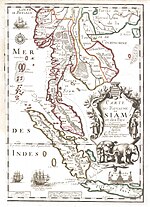| History of Thailand |
|---|
 |
|
|
Before the Tai people's southward migration from Guangxi since the 4th century, the Indochinese peninsula had already been populated by Austronesians who by around 30,000 BP had spread into all sub-regions. They left traces of the first local culture - the Hoabinhian, a name assigned to an industry and cultural continuity of stone tools and flaked cobble artifacts that appears around 10,000 BP in caves and rock shelters first described in Hòa Bình, Vietnam, later also documented in Terengganu, Malaysia, Sumatra, Thailand, Laos, Myanmar, Cambodia and Yunnan, southern China.[1][2]
Austroasiatic Mon and Khmer groups, who originate in North-Eastern India predominantly populated the riverine lowlands of Indochina since around 5000 years BP. Austronesian immigrants arrived at the coast of central modern Vietnam around 2500 BP.[3][4][5][6][7][8]
The controversial Two layer hypothesis suggests the immigration of settlers arriving from the Yangtze River valley around 3,000 BP, who introduced wet-rice and millet farming techniques in Mainland Southeast Asia.[9] The site of Ban Chiang in North-eastern Thailand currently ranks as the earliest known center of copper and bronze production in Southeast Asia and has been dated to around 2,000 years BCE.[10]
The oldest known records of a political entity in Indochina are attributed to Funan - centered in the Mekong Delta and comprising territories inside modern day Thailand.[11] Chinese annals confirm Funan's existence as early as the 1st century CE, but archaeological documentation implies an extensive human settlement history since the 4th century BCE.[12] The Langkasuka and Tambralinga kingdoms on the Malay peninsula appear in Chinese texts by the fifth century. As well as Funan these polities are characterized as fully developed Indianized kingdoms, which after centuries of trade and socio-economic interaction with India had adopted and incorporated elements of Indian culture, religion, statecraft, administration, epigraphy, literature and architecture.[13][14]
The Mon Dvaravati principalities also appear during the middle of the first millennium in the lower Chao Phraya River valley of modern-day central Thailand.[15] Unlike Funan, Langkasuka and Tambralinga that were situated in the center of the international trade network Dvaravati remained relatively isolated. Although distinct, the sophisticated Mon-Dvaravati culture is based on Hindu cosmology. Its characteristic art style "such as the faceted miter sitting high on the forehead ... the facial features, especially the eyes″ has influenced Thai sculpture to this day.[16]
- ^ Marwick, Ben (December 2013). "Multiple Optima in Hoabinhian flaked stone artefact palaeoeconomics and palaeoecology at two archaeological sites in Northwest Thailand". Journal of Anthropological Archaeology. 32 (4): 553–564. doi:10.1016/j.jaa.2013.08.004.
- ^ Ji, Xueping; Kuman, Kathleen; Clarke, R.J.; Forestier, Hubert; Li, Yinghua; Ma, Juan; Qiu, Kaiwei; Li, Hao; Wu, Yun (May 2016). "The oldest Hoabinhian technocomplex in Asia (43.5 ka) at Xiaodong rockshelter, Yunnan Province, southwest China". Quaternary International. 400: 166–174. Bibcode:2016QuInt.400..166J. doi:10.1016/j.quaint.2015.09.080.
- ^ Tarling, Nicholas (1999). The Cambridge History of Southeast Asia, Volume One, Part One. Cambridge University Press. ISBN 978-0-521-66369-4. Retrieved 3 January 2017.
- ^ Sidwell, Paul; Blench, Roger (2011). "The Austroasiatic Urheimat: the Southeastern Riverine Hypothesis" (PDF). In Enfield, N.J. (ed.). Dynamics of Human Diversity. Canberra: Pacific Linguistics. pp. 317–345. ISBN 9780858836389.
- ^ "THE AUSTRONESIAN SETTLEMENT OF MAINLAND SOUTHEAST ASIA" (PDF). Sealang. Retrieved 10 February 2018.
- ^ Lipson, Mark; Loh, Po-Ru; Patterson, Nick; Moorjani, Priya; Ko, Ying-Chin; Stoneking, Mark; Berger, Bonnie; Reich, David (19 August 2014). "Reconstructing Austronesian population history in Island Southeast Asia". Nature Communications. 5: 4689. Bibcode:2014NatCo...5.4689L. doi:10.1038/ncomms5689. PMC 4143916. PMID 25137359.
- ^ "Austronesian Southeast Asia: An outline of contemporary issues". Omnivoyage. Archived from the original on 25 September 2016. Retrieved 2 January 2017.
- ^ "Origins of Ethnolinguistic Identity in Southeast Asia" (PDF). Roger Blench. Retrieved 10 February 2018.
- ^ Charles Higham. "Hunter-Gatherers in Southeast Asia: From Prehistory to the Present". Digitalcommons. Retrieved 10 February 2018.
- ^ Higham, Charles; Higham, Thomas; Ciarla, Roberto; Douka, Katerina; Kijngam, Amphan; Rispoli, Fiorella (10 December 2011). "The Origins of the Bronze Age of Southeast Asia". Journal of World Prehistory. 24 (4): 227–274. doi:10.1007/s10963-011-9054-6. S2CID 162300712.
- ^ "THE VIRTUAL MUSEUM OF KHMER ART - History of Funan - The Liang Shu account from Chinese Empirical Records". Wintermeier collection. Retrieved 10 February 2018.
- ^ "State-Formation of Southeast Asia and the Regional Integration - "thalassocratic" state - Base of Power is in the control of a strategic points such as strait, bay, river mouth etc. river mouth etc" (PDF). Keio University. Retrieved 10 February 2018.
- ^ National Library of Australia. Asia's French Connection : George Coedes and the Coedes Collection Archived 21 October 2011 at the Wayback Machine
- ^ Han, Wang; Beisi, Jia (2016). "Urban Morphology of Commercial Port Cities and Shophouses in Southeast Asia". Procedia Engineering. 142: 190–197. doi:10.1016/j.proeng.2016.02.031.
- ^ "Dvaravati ANCIENT KINGDOM, ASIA". Encyclopedia Britannica. Retrieved 10 February 2018.
- ^ "The Mon-Dvaravati Tradition of Early North-Central Thailand". The Metropolitan Museum of Art. Retrieved 10 February 2018.
